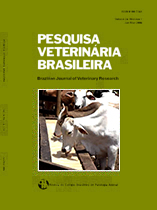 |
|
|
|
Year 2015 - Volume 35, Number 12
|

|
Epiphora assessment of dogs with dacryocystography and computed tomography, 35(12):989-996
|
ABSTRACT.- Vieira N.M.G., Ranzani J.J.T., Brandão C.V.S., Cremonini D.N., Schellini S.A., Padovani C.R., Vulcano L.C. & Almeida M.F. 2015. [Epiphora assessment of dogs with dacryocystography and computed tomography.] Avaliação da epífora de cães usando dacriocistografia e tomografia computadorizada. Pesquisa Veterinária Brasileira 35(12): 989-996. Serviço de Oftalmologia Veterinária, Departamento de Cirurgia e Anestesiologia, Faculdade de Medicina Veterinária e Zootecnia, Universidade Estadual Paulista, Distrito de Rubião Jr s/n, Botucatu, SP 18618-970, Brazil. E-mail: niveamgv@yahoo.com.br
Epiphora evaluation can be done through clinical exams, lachrymal excretion tests, contrasted exams, like radiologic evaluation and tomography studies; those last two allow a detailed analysis of the structures. The present study had as the objective to evaluate the lacrimal drainage system through radiography and contrasted computed tomography, which were made with animals presenting epiphora, comparing them to healthy animals, without the mentioned condition. Twenty dogs were used for tests, from a variety of breeds and coatings, males and females, weight varying from 1kg to 20kg, ages varying from 0.7 to 8 years old, presenting epiphora (epiphora group - GE*). As a control group (GC*) 15 dogs were used, with no clinical alterations of naso-lachrymal drainage system, from different breeds and coatings, males and females, weighing from 1kg to 20kg and ages varying from 0.7 to 8 years old. It was propoused the division of the lacrimal drainage system in four regions. On region 1, the GE had 29 (76.3%) animals with dilation visualized by the RX and 32 (84.2%) by CT, the GC, 4 (12.5%) in the RX and 1 (3.1% ) CT showed dilation. In region 3, 13 (34.2%) dogs showed dilatation of the DLN in RX and 14 (36.8%) on CT, and 21 (55.3%) nasolacrimal duct communication with the sinus and the X-ray 28 (73.7%) by CT. For the CG, 15 (46.9%) the X-ray and 22 (68.7%) by CT had nasolacrimal duct communication with the nasal sinus. It has been concluded that dilations can also be observed in some dogs with no clinical signs of disease; nasolacrimal duct communication to sinus does not indicate epiphora causing alteration, as it is present in animals with and without affection; the present study data confirm that DCG itself can provide important informations, in a similar manner to CT, and should resort to it just in case of doubts about bone lesions, fractures and foreign bodies undetected at first. |
| |
|
|
| |
|
 |